Papers by Montri Chaisawang
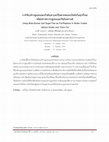
Burapha Science Journal (วารสารวิทยาศาสตร์บูรพา ), Feb 14, 2019
The influence of beta-glucan and sugar pea as fat-replacers for the production of butter cookie m... more The influence of beta-glucan and sugar pea as fat-replacers for the production of butter cookie made from tapioca starch on the physical properties of dough and trans fat contents were studied. The incorporation of these two components was found to improve elastic dough with no breaking during extended the molding step. Butter cookies containing beta-glucan and sugar pea expressed low spread ratio, low yellow color, increase hardness and accepted overall acceptability. In addition, the contents of protein and dietary fiber in the butter cookies increased in our recipe. Subsequently, the fat content decreased by 30% when compared with control. Our developed recipe of butter cookies showed no composition of trans fat. Thus, the results showed the possibility of utilizing ground sugar pea and beta-glucan to improve the physical and nutritional properties of butter cookies. It may lead to an adaptation of recipes in the industry due to Thai food law.
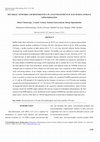
Brazilian Journal of Microbiology, Sep 1, 2012
Baffled shake flask cultivation of Aurantiochytrium sp. B-072 was carried out at in a glucose-mon... more Baffled shake flask cultivation of Aurantiochytrium sp. B-072 was carried out at in a glucose-monosodium glutamate mineral medium at different C/N-ratios with glucose fixed at 90 g/L. With increasing C/N-ratio, a modest increase in lipid content (60 to 73 % w/w) was observed whereas fat-free biomass decreased but overall biomass showed little variation. FA-profiles were not affected to a large extent by C/N-ratio and absolute docosahexaenoic (DHA)-levels fell in narrow range (5-6 g/L). However at C/N > 64 a rapid decrease in lipid synthetic rate and/or incomplete glucose utilization occurred. Glucose and FAfluxes based on fat-free biomass peaked at a C/N ratio of 56. This condition was chosen for calculation of the redox balance (NAD(P)H) and energy (ATP) requirement and to estimate the in vivo P/O ratio during the main period of fatty acid biosynthesis. Several models with different routes for NADPH, acetyl-CoA formation and re-oxidation of OAA formed via ATP-citrate lyase were considered as these influence the redox-and energy balance. As an example, using a commonly shown scheme whereby NADPH is supplied by a cytosolic "transhydrogenase cycle" (pyruvate-OAA-malate-pyruvate) and OAA formed by ATP-citrate lyase is recycled via import into the mitochondria as malate, the calculated NADPH-requirement amounted to 5.5 with an ATP-demand of 10.5 mmol/(g fat-free biomass x h) and an in vivo P/O-ratio (not including non-growth associated maintenance) of 1.6. The lowest ATP requirement is found when acetyl-CoA would be transported directly from the mitochondria to the cytosol by carnitine acetyltransferase. Assay of some enzymes critical for NADPH supply indicates that activity of glucose-6-phosphate dehydrogenase, the first enzyme in the HMP pathway, is far insufficient for the required NADPH-flux and malic enzyme must be a major source. Activity of the latter (ca. 300 mU/mg protein) far exceeds that in oleaginous fungi and yeast.
Burapha Science Journal (วารสารวิทยาศาสตร์บูรพา ), Jan 15, 2020
The objectives of this research are to study the current property of the dough while heated in th... more The objectives of this research are to study the current property of the dough while heated in the oven. Physical properties and sensory evaluation of butter cookies replacing butter with the following types of hydrocolloids: guar gum, xanthan gum, beta-glucan, and gum arabic. To examine the function of using as a fat substitute in butter cookies at different concentrations, the amount of used butter was reduced from 20% to 50%. Substitution of guar gum and beta-glucan found that the physical properties and consumer acceptance were better than xanthan gum and gum arabic. Sensory analysis of fat-reducing butter cookies shows that replacing some butter with guar gum and beta-glucan can be used up to 50% of butter without any effect on consumer's acceptability.

Project name : Localization of related enzyme and metabolic flux in oleaginous species Researcher... more Project name : Localization of related enzyme and metabolic flux in oleaginous species Researcher name : Dr. Montri Chaisawang Just as important is the high amount of MCFA and LC-PUFA produced by Thraustochytrium sp. B01, a potential source for large-scale oil production for biodiesel and DHA. Heterotrophic growth of thraustochytrid has potential in coproducing saturated fatty acid (SFA) or medium chain fatty acid (MCFA) for biodiesel and long-chain polyunsaturated fatty acids (LC-PUFA), namely arachidonic acid (ARA), eicosapentaenoic acid (EPA), docosapentaenoic acid (DPA) and docosahexaenoic acid (DHA) for use in nutraceuticals. In this study, we proposed new Thailand thraustochytrid strains on the basis of 18S rRNA sequencing. The result showed a close phylogenic relationship and highest percentage of similarity to Thraustochytrids sp. strain. Physiological screening including initial pH, seawater concentration, glucose concentration and temperature was carry out for optimization of culture conditions of Thraustochytrid sp. B01 for biomass and total fatty acid production. The lipid productivity of 0.35 g/L/h was obtained by Thraustochytrium sp. B01 with glucose as carbon source in baffled shake flask cultivation indicating a potential source for large-scale oil production for biodiesel and DHA. The production of NADPH for fatty acid biosynthesis is dependent of malic enzyme, isocitrate dehydrogenase and glucose-6-phosphate dehydrogenase, respectively.
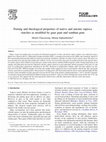
Food Hydrocolloids, Jul 1, 2006
Effects of guar and xanthan gums on pasting and rheological properties of native and anionic tapi... more Effects of guar and xanthan gums on pasting and rheological properties of native and anionic tapioca starches were studied by using a Rapid Visco-Analyzer (RVA), a differential scanning calorimeter (DSC), a scanning electron microscope (SEM), and a rheometer. Results of RVA measurement indicated that addition of gums increased peak, breakdown, and final viscosities of native tapioca starch. This effect was more pronounced for guar gum than xanthan gum. Setback viscosity was increased by guar gum, but xanthan gum showed the opposite effect. For anionic tapioca starch, addition of guar gum gave similar results whereas xanthan exhibited opposite results. Pasting temperatures of all samples with added gums increased in comparison with the controls which are in good agreement with the increments of the onset (T o ) and peak (T p ) gelatinization temperatures determined by the DSC. Reduction of gelatinization enthalpy (DH) with gums addition was also observed by the DSC. SEM micrographs reveal that only xanthan totally wrapped the native starch granules whereas the other starch-gum mixtures, gums did not wrap the granules. Measurement of swelling power (SP) demonstrated that the anionic starch exhibited higher SP than the native starch and addition of gums appeared to increase the SP values of the mixtures at high temperatures (O80 8C). Results of dynamic viscoelasticity measurement indicated that addition of gums increased the G 0 values two-fold at all frequencies tested, but the ratio G 00 /G 0 (tan d) was decreased. This suggests that the starch-gum pastes behaved more solid-like characteristics than the starch alone pastes.
Rajamangala University Of Technology Rattanakosin, 2018

Code of project : A40 / 2558 Project name : Localization of related enzyme and metabolic flux in ... more Code of project : A40 / 2558 Project name : Localization of related enzyme and metabolic flux in oleaginous species Researcher name : Dr. Montri Chaisawang Just as important is the high amount of MCFA and LC-PUFA produced by Thraustochytrium sp. B01, a potential source for large-scale oil production for biodiesel and DHA. Heterotrophic growth of thraustochytrid has potential in coproducing saturated fatty acid (SFA) or medium chain fatty acid (MCFA) for biodiesel and long-chain polyunsaturated fatty acids (LC-PUFA), namely arachidonic acid (ARA), eicosapentaenoic acid (EPA), docosapentaenoic acid (DPA) and docosahexaenoic acid (DHA) for use in nutraceuticals. In this study, we proposed new Thailand thraustochytrid strains on the basis of 18S rRNA sequencing. The result showed a close phylogenic relationship and highest percentage of similarity to Thraustochytrids sp. strain. Physiological screening including initial pH, seawater concentration, glucose concentration and temperature w...

The gelatinization of native and modified tapioca starch embedded in gum matric was investigated ... more The gelatinization of native and modified tapioca starch embedded in gum matric was investigated by using a Rapid Visco-Analyzer (RVA), Differential Scanning Calorimeter (DSC), swelling power and solubility index measurements, Scanning Electron Microscope (SEM), and rheometer. Xanthan and guar gums increased RVA peak viscosity of native and modified tapioca starch during pasting synergistically by different phenomena; except for anionic starch-xanthan gum mixture. Guar gum was more effective than xanthan gum in term of increasing peak viscosity due to the interactions between leached components, amylose and short chain amylopectin, and gums. The increasing viscosity was not affected by swelling power of native and anionic starch suspensions. On the contrary, swelling power of cationic starch was greatly decreased in xanthan gum solution due to aggregation of gum and starch granules. Xanthan gum enwrapped several adjacent granules and induced association between the gelatinized granu...
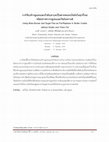
The influence of beta-glucan and sugar pea as fat-replacers for the production of butter cookie m... more The influence of beta-glucan and sugar pea as fat-replacers for the production of butter cookie made from tapioca starch on the physical properties of dough and trans fat contents were studied. The incorporation of these two components was found to improve elastic dough with no breaking during extended the molding step. Butter cookies containing beta-glucan and sugar pea expressed low spread ratio, low yellow color, increase hardness and accepted overall acceptability. In addition, the contents of protein and dietary fiber in the butter cookies increased in our recipe. Subsequently, the fat content decreased by 30% when compared with control. Our developed recipe of butter cookies showed no composition of trans fat. Thus, the results showed the possibility of utilizing ground sugar pea and beta-glucan to improve the physical and nutritional properties of butter cookies. It may lead to an adaptation of recipes in the industry due to Thai food law. Keywords : butter cooki...
The objectives of this research are to study the current property of the dough while heated in th... more The objectives of this research are to study the current property of the dough while heated in the oven. Physical properties and sensory evaluation of butter cookies replacing butter with the following types of hydrocolloids: guar gum, xanthan gum, beta-glucan, and gum arabic. To examine the function of using as a fat substitute in butter cookies at different concentrations, the amount of used butter was reduced from 20% to 50%. Substitution of guar gum and beta-glucan found that the physical properties and consumer acceptance were better than xanthan gum and gum arabic. Sensory analysis of fat-reducing butter cookies shows that replacing some butter with guar gum and beta-glucan can be used up to 50% of butter without any effect on consumer’s acceptability. Keywords : butter cookie, hydrocolloids, dough’s viscoelastic behavior, physical properties
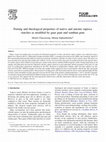
Food Hydrocolloids, 2006
Effects of guar and xanthan gums on pasting and rheological properties of native and anionic tapi... more Effects of guar and xanthan gums on pasting and rheological properties of native and anionic tapioca starches were studied by using a Rapid Visco-Analyzer (RVA), a differential scanning calorimeter (DSC), a scanning electron microscope (SEM), and a rheometer. Results of RVA measurement indicated that addition of gums increased peak, breakdown, and final viscosities of native tapioca starch. This effect was more pronounced for guar gum than xanthan gum. Setback viscosity was increased by guar gum, but xanthan gum showed the opposite effect. For anionic tapioca starch, addition of guar gum gave similar results whereas xanthan exhibited opposite results. Pasting temperatures of all samples with added gums increased in comparison with the controls which are in good agreement with the increments of the onset (T o ) and peak (T p ) gelatinization temperatures determined by the DSC. Reduction of gelatinization enthalpy (DH) with gums addition was also observed by the DSC. SEM micrographs reveal that only xanthan totally wrapped the native starch granules whereas the other starch-gum mixtures, gums did not wrap the granules. Measurement of swelling power (SP) demonstrated that the anionic starch exhibited higher SP than the native starch and addition of gums appeared to increase the SP values of the mixtures at high temperatures (O80 8C). Results of dynamic viscoelasticity measurement indicated that addition of gums increased the G 0 values two-fold at all frequencies tested, but the ratio G 00 /G 0 (tan d) was decreased. This suggests that the starch-gum pastes behaved more solid-like characteristics than the starch alone pastes.
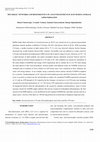
Brazilian Journal of Microbiology, 2012
Baffled shake flask cultivation of Aurantiochytrium sp. B-072 was carried out at in a glucose-mon... more Baffled shake flask cultivation of Aurantiochytrium sp. B-072 was carried out at in a glucose-monosodium glutamate mineral medium at different C/N-ratios with glucose fixed at 90 g/L. With increasing C/N-ratio, a modest increase in lipid content (60 to 73 % w/w) was observed whereas fat-free biomass decreased but overall biomass showed little variation. FA-profiles were not affected to a large extent by C/N-ratio and absolute docosahexaenoic (DHA)-levels fell in narrow range (5-6 g/L). However at C/N > 64 a rapid decrease in lipid synthetic rate and/or incomplete glucose utilization occurred. Glucose and FAfluxes based on fat-free biomass peaked at a C/N ratio of 56. This condition was chosen for calculation of the redox balance (NAD(P)H) and energy (ATP) requirement and to estimate the in vivo P/O ratio during the main period of fatty acid biosynthesis. Several models with different routes for NADPH, acetyl-CoA formation and re-oxidation of OAA formed via ATP-citrate lyase were considered as these influence the redox-and energy balance. As an example, using a commonly shown scheme whereby NADPH is supplied by a cytosolic "transhydrogenase cycle" (pyruvate-OAA-malate-pyruvate) and OAA formed by ATP-citrate lyase is recycled via import into the mitochondria as malate, the calculated NADPH-requirement amounted to 5.5 with an ATP-demand of 10.5 mmol/(g fat-free biomass x h) and an in vivo P/O-ratio (not including non-growth associated maintenance) of 1.6. The lowest ATP requirement is found when acetyl-CoA would be transported directly from the mitochondria to the cytosol by carnitine acetyltransferase. Assay of some enzymes critical for NADPH supply indicates that activity of glucose-6-phosphate dehydrogenase, the first enzyme in the HMP pathway, is far insufficient for the required NADPH-flux and malic enzyme must be a major source. Activity of the latter (ca. 300 mU/mg protein) far exceeds that in oleaginous fungi and yeast.

Carbohydrate Polymers, 2005
ABSTRACT The gelatinization of cationic tapioca starch embedded in gum matrices was investigated ... more ABSTRACT The gelatinization of cationic tapioca starch embedded in gum matrices was investigated by using a Rapid Visco-Analyzer (RVA), differential scanning calorimeter (DSC), scanning electron microscope (SEM), and rheometer. In addition, swelling power and solubility indices were measured. Xanthan and guar gum increased the RVA peak viscosity of cationic tapioca starch during pasting synergistically in different ways. Guar gum was more effective than xanthan gum in terms of increasing peak viscosity due to its ability to increase the swelling power and solubility index. Both xanthan gum and guar gum induced association between the gelatinized granules probably due to bridging. Association was much more extensive with xanthan. DSC studies showed that the presence of gums influenced the gelatinization characteristics of starch significantly by increasing the onset gelatinization temperature and decreasing the gelatinization enthalpy. Dynamic rheological measurement showed a strong interaction occurred in the cationic tapioca starch–xanthan gum mixture resulting in a decrease in the loss tangent (tan δ) as compared with guar gum addition or starch alone. The ionic interaction of gums and starch was found to play an important role in the gelatinization characteristics of the mixtures and also rheological properties of the pastes.
Uploads
Papers by Montri Chaisawang